Telephone-Based Cognitive-Behavioral Therapy for Latino Patients Living in Rural Areas: A Randomized Pilot Study
Abstract
Objective:
This pilot study tested the effectiveness of culturally tailored, telephone-based cognitive-behavioral therapy (CBT) for improving depression outcomes among Latino primary care patients living in rural settings.
Methods:
A total of 101 Latino patients at a rural family medical center who met criteria for probable major depression were randomly assigned to enhanced usual care or eight sessions of CBT delivered by phone by trained bilingual therapists from the community. Blinded study assistants assessed depression symptom severity, using the Hopkins Symptom Checklist (SCL) depression items and the Patient Health Questionnaire-9, and patient satisfaction after six weeks, three months, and six months. Mixed-effects models were used to estimate intervention effects over time. For cross-sectional analyses, attrition weights were used to account for missing data.
Results:
In intent-to-treat analyses, patients who received CBT by phone were more likely to experience improvement in depression scores over the six-month follow-up period compared with patients who received enhanced usual care (β=−.41, t=−2.36, df=219, p=.018, for the SCL; and β=−3.51, t=−2.49, df=221, p=.013, for the PHQ-9). A greater proportion of patients in the CBT group than in the group that received enhanced usual care achieved treatment response at three months (p=.017), as indicated by a 50% improvement in SCL depression score or a score <.75, and reported high satisfaction with treatment (p=.013).
Conclusions:
Although limited by small sample size, pilot results suggest culturally tailored, telephone-based CBT has the potential to enhance access to psychotherapy in an underserved Latino population with little access to mental health services. (Psychiatric Services 62:936–942, 2011)
Despite similar need for depression care across ethnic groups, Latinos have lower rates and quality of treatment, resulting in a greater burden of disability from depression (1,2). Among Latinos, Mexican Americans, immigrants, non-English speakers, and men are particularly unlikely to receive depression care (1,3,4). Because Mexican Americans account for two-thirds of the Latino population in the United States, addressing disparities in depression care among this group is of key public health import (1,5).
When they do receive depression care, Latinos are most likely to prefer psychotherapy (1,6); however, psychotherapy is rarely available in primary care, and few Latinos, especially those who are immigrants or from low-income groups, have access to specialty mental health care (7). Culturally tailored cognitive-behavioral therapy (CBT) has been shown effective for treating depression among low-income Latinos; however, many have difficulty adhering to psychotherapy because of multiple competing demands (8). Latinos living in rural areas face additional burdens of long travel distances, lack of public transportation, lack of bilingual or bicultural mental health providers, and privacy and stigma concerns in small communities.
Delivery of CBT by telephone provides several potential advantages compared with delivery in person among Latinos living in rural communities. Patients can receive treatment in a private setting of their choice, potentially reducing stigma and enhancing treatment acceptance, and can avoid the need to travel to distant clinics in areas lacking public transportation. Therapists can be available to large areas without traveling between sites and can offer treatment outside normal clinic hours. Yet despite its usefulness in and acceptance by other populations, concerns remain about the effectiveness of telephone therapy among Latinos because of cultural values that emphasize interpersonal rapport (personalismo) and nonverbal communication (9–12).
We conducted a randomized, controlled pilot study of culturally tailored CBT provided by telephone to Latino primary care patients in rural settings. We examined its effectiveness in improving depression outcomes and patient satisfaction compared with results for usual primary care. This study was approved by the Human Subjects Committees of the University of Washington and the Yakima Valley Farm Workers Clinic.
Methods
Setting
Yakima Valley Farm Workers Clinic is a nonprofit network of 17 rural health centers in the state of Washington, including the study site, the Family Medical Center in Walla Walla. In 2008 the center served8,559 medical or pediatric patients, of whom 53% were Latino, 44% Spanish speaking, 21% seasonal farm workers,7% migrant farm workers, and 31% uninsured.
Recruitment
Three local residents who spoke both Spanish and English and who were familiar with both the local Mexican-American and mainstream cultures were trained and hired part-time to approach patients in the waiting room to ask if they would like to hear about a depression research study. Clinic providers could also refer patients for screening. Patients who agreed were taken to a private area where study recruiters conducted a brief interview. Adult primary care patients were eligible for the study if they self-identified as Latino; spoke English or Spanish; screened positive for probable major depressive disorder; and screened negative for bipolar disorder, cognitive impairment, current or lifetime psychotic symptoms or disorder, current substance abuse, or acute suicidal ideation. Patients were eligible even if they were already receiving antidepressant medication. No study-eligible patient had to be excluded because of lack of access to a telephone.
The Patient Health Questionnaire-9 (PHQ-9) was used to assess probable major depression; criteria were the reporting of a minimum of five of the nine symptoms assessed and a cutoff score of 10 (13,14). Probable bipolar disorder was assessed using the Mood Disorder Questionnaire (15). We screened for psychotic disorders using three stem items from the psychotic disorders module of the Composite International Diagnostic Interview (CIDI) (16) and one question regarding lifetime history of psychotic disorder from the Improving Mood-Promoting Access to Collaborative Treatment (IMPACT) study (17). Cognitive impairment was assessed by using a six-item screener derived from the Mini-Mental State Examination (MMSE) (18). The MMSE is validated in Spanish and among Mexican Americans (19), and we employed the six-item screener in previous trials with low-income Latino patients in primary care (20). Suicidal ideation was assessed by using a protocol based on the PHQ-9 and standard clinical interviews. The CAGE-AID, a four-item questionnaire validated among primary care patients, was used to screen out current alcohol and substance abuse (21). Using the validated Spanish version of the CAGE, known as the 4M (22), as a guide, the CAGE-AID was translated into Spanish, reviewed, and translated back into English by bilingual study personnel from at least two Spanish-speaking countries.
Patients who responded affirmatively when asked if during the past two weeks they had had thoughts that they would be better off dead or had wanted to hurt themselves were asked structured questions devised by the study team to assess suicidal ideation. The recruiters also used a standardized procedure to discuss the case with the principal investigators, arrange urgent evaluation if necessary, and communicate the safety plan to the primary care provider.
Study procedures were explained fully to the patients, and written informed consent in the patient's preferred language was obtained. Enrolled patients completed baseline surveys described below. Patients were then assigned to receive usual care or CBT by telephone by stratified permuted-block randomization, with strata defined by gender and referral source.
Enhanced usual care
Providers were free to provide any usually available care for depression, including antidepressants or referral to outside services. Care was considered enhanced because patients were encouraged to talk with their primary care provider about depression treatment and providers received a letter informing them of their patient's depression status and study enrollment.
CBT by telephone
CBT was provided at no charge in eight telephone sessions; each session focused on a chapter from a patient workbook that had been translated into the Spanish language for this study (9). The content of examples and vignettes were modified to use Latino names and reflect situations relevant to rural Latinos. Bilingual members of the study team (some with farm worker backgrounds) reviewed the translated manual to ensure that language, idioms, and vignettes were appropriate for the local Latino context and culture. The workbook included didactic material, exercises for each session, and written exercises for completion between sessions. The workbook was mailed to participants in the CBT telephone intervention after randomization, and patients were asked to read the relevant workbook chapter before each session.
In general, patients completed the modules in order, but the schedule was sometimes modified—for example, to switch the order of modules or to use two sessions for a single module. In response to the cultural value of personalismo, patients were given the option to conduct their first session in person. Each session was scheduled in advance (approximately weekly), but missed appointments were frequent, necessitating that therapists extend persistent outreach and expand traditional clinic hours to accommodate patients' work schedules. Sessions were designed to last 45 to 50 minutes, but the actual duration varied according to clinical need and patient preference.
The content of the phone interventions is described elsewhere (10); briefly, each intervention emphasized behavioral activation (23,24) and strategies for identifying, interrupting, and distancing oneself from negative thoughts (25,26). During each session, therapists followed a detailed outline. Each session included structured assessment of depressive symptoms with the PHQ-9 (27) (five minutes), review of the previous session's content (five minutes); debriefing of previous homework assignment (five to ten minutes), introduction of new material (15 to 20 minutes), description of the new homework assignment (five to ten minutes), and a motivational assessment and enhancement exercise focused on the homework assignment (five minutes).
The initial session also included a structured assessment of clinical history, assessment of motivation for treatment, and use of strategies to enhance patients' motivation to engage in treatment, such as exploring options for depression treatment and feelings of ambivalence about treatment (28). If indicated by symptom acuity, therapists made brief supportive telephone contacts between sessions.
Based on clinical judgment, the study therapist could refer the patient for case management services for depression care needs, such as assistance in making appointments with clinic providers and referrals to community services. The therapist did not take an active role in management of antidepressant medication but could discuss medication as a treatment option, ask about medication adherence, and—with participants' consent—communicate with prescribing providers. The therapist made no specific medication recommendations, and all questions related to medication were referred back to prescribing physicians.
Telephone sessions were conducted by five part-time therapists hired for the study: a student working toward a master of social work degree (M.S.W.) who had experience as a community social worker, an experienced therapist with an M.S.W., an individual with an M.S.W. and experience in social work but not in therapy, and two M.S.W. students with limited clinical experience. All were Latino or Latina and spoke Spanish.
The therapists' training for the study consisted of a full-day workshop introducing general concepts of the intervention and reviewing the eight sessions. Next, each therapist reviewed the manual independently and then participated in a group teleconference to review questions and role-play material from the first session. The two M.S.W.-student therapists augmented this training by role-playing the entire manual by telephone.
Each study therapist was assigned up to two practice cases. As each session was completed, the therapist sent encrypted digital recordings to an interdisciplinary group of supervisors (two social workers, a psychiatrist, and a psychologist), who provided feedback in weekly group telephone supervision. Once each therapist was deemed competent by the supervision team, he or she was assigned study cases. The therapists continued to have weekly group supervision, and selected session recordings were reviewed by supervisors throughout the study.
Each therapist was asked to complete a computerized tracking sheet that recorded each patient contact (including no-shows and reminder calls) and patients' depressive symptom severity as measured by the PHQ-9 (27) at each session. Supervisors and therapists used these sheets to review the status of their caseload during weekly supervision.
Data collection and measures
Interviews were conducted in Spanish or English (on the basis of patient preference) in person by study recruiters at baseline (before randomization) and by telephone by project assistants masked to patients' randomization status at six weeks, three months, and six months. Unless otherwise noted, all measures were available in Spanish and had been previously used for Latino populations.
Baseline interview.
The baseline interview assessed depression symptom severity with the PHQ-9 and depression items from the Hopkins Symptom Checklist (SCL) (29,30). It also assessed gender, age, marital status, education, employment status, insurance status, race-ethnicity, nativity, language preference, length of residence in the United States, comorbid medical conditions, previous depression treatment, perceived need for depression treatment, and potential barriers to depression care using items adapted from the Partners in Care (PIC) study (31) and Patients and Clinics Together for Health (6,20). The Patient Health Questionnaire batteries for panic and generalized anxiety disorders (19,20) and the Posttraumatic Stress Disorder Checklist-Civilian Version (PCL-C) (32,33) were used to screen for anxiety disorders.
Follow-up interviews.
All follow-up interviews assessed depression symptoms with the PHQ-9 and with depression items from the SCL and assessed patient-rated satisfaction with treatment using a 7-point Likert scale, from 1, indicating very satisfied, to 7, indicating very dissatisfied. The scale has been used by Simon and others (9) and in studies of depression intervention in primary care (34–36) and was translated into Spanish using methods described above.
Depression outcomes.
Possible PHQ-9 scores range from 0 to 27, with higher scores indicating more severe depression. Possible scores on the SCL depression items range from 0 to 4; scores >2.0 represent severe depression; between 1.5 and 2.0, moderate depression; and between .75 and 1.5, mild depression. Scores <.75 did not meet the threshold for depression. For each scale, treatment response was defined as an improvement of >50% in the overall score or scoring below the cutoff for depressive disorder (<10 on the PHQ-9 and <.75 on the SCL).
Analyses
Using t tests and chi square tests for continuous and categorical variables, respectively, we compared demographic characteristics and depression symptoms at baseline by intervention group. To determine the intervention effect, we used an intent-to-treat approach, in which all eligible patients with a baseline interview were included in analyses even if they missed interviews or did not participate in treatment sessions. To estimate the intervention effect over time, we jointly modeled the outcomes at the four assessment times (baseline, six weeks, three months, and six months) by time, intervention, and the interaction between time and intervention using a mixed-effects model (in which patients' data were treated as random effects). The beta coefficient associated with each assessment time represents the average change from baseline experienced by the CBT group above and beyond that experienced by the group receiving enhanced usual care. Time was treated as a categorical variable, and all the models included probable anxiety disorder as a covariate because patients receiving enhanced usual care were significantly more likely to screen positive for anxiety disorders at baseline.
There was a trend toward lower rates of insurance coverage among patients who received enhanced usual care compared with those receiving CBT; however, baseline insurance status was not predictive of outcomes, and inclusion of insurance status as a covariate in the models did not significantly change results. Thus insurance status was dropped from the final models. We fitted the model using a restricted maximum-likelihood approach, which produces valid estimates under the missing-at-random assumption (37). This approach correctly handles the additional uncertainty arising from missing data and uses all available data to obtain unbiased estimates for model parameters (38). For cross-sectional analyses, such as those assessing the percentage of responders at the three follow-up times, we used attrition weights to correctly account for patients who missed one or more follow-up assessments (39). For all analyses we used R, version 2.11.1.
Results
From April 2008 to February 2009, we screened 869 patients (851 from the waiting room and 18 from provider referral). Of these, 119 (14%) screened positive for probable major depression and met eligibility criteria; 101 (85% of those considered eligible) were enrolled and were assigned at random to the treatment groups. [A flowchart showing the screening, enrollment, and follow-up of patients is available in an online appendix to this article at ps.psychiatryonline.org.]
Forty-two (84%) patients who received CBT completed six-month assessments, compared with 35 (70%) patients in enhanced usual care. Baseline characteristics of the sample are presented in Table 1. Those randomly assigned to enhanced usual care had higher rates of comorbid anxiety disorders than did the CBT group, but otherwise the groups had similar baseline characteristics. The mean±SD SCL score at baseline for each group was 1.8±.8, indicating moderate depression.
Patients in the CBT group completed a mean of 4.62±3.19 sessions. Forty-four (88%) received at least one session, 27 (54%) completed four or more sessions, and 22 (44%) completed six or more sessions. Eleven patients (22%) opted to receive their first CBT session in person. On average, patients in enhanced usual care reported having had fewer than one in-person or telephone contact with a doctor or counselor between follow-up phone calls (mean±SD=.2±1.1). Among the 77 patients assessed at six months, 15 (36%) patients receiving CBT and 11 (30%) patients receiving enhanced usual care reported use of antidepressants in the previous six weeks, a difference that was not statistically significant.
Over the six-month follow-up period, patients randomly assigned to CBT experienced greater reductions in scores on both the PHQ-9 and the SCL, as predicted by repeated-measures linear mixed-effects models that controlled for presence of comorbid anxiety disorder, than those receiving enhanced usual care (β=–.41, t=–2.36, df=219, p=.018, for the SCL; and β=–3.51, t=–2.49, df=221, p=.013, for the PHQ-9) (Figures 1 and 2). Table 2 shows the mean SCL and PHQ-9 scores predicted by our models.
Table 3 shows the proportions of patients who responded to treatment at each time point, adjusted for nonresponse via attrition weights. Patients who received CBT were significantly more likely to have achieved response at three months, as measured by the SCL, than were those in enhanced usual care, and there was a trend toward patients receiving CBT to be more likely to respond by six months, as measured by the PHQ-9. Patients in the CBT group were significantly more likely to report satisfaction with depression treatment than were those in enhanced usual care.
Discussion
Our results provide initial evidence of effectiveness of telephone CBT for improving depression outcomes and patient satisfaction among Latino patients in rural primary care settings. Compared with the mostly Caucasian, urban, insured population studied by Simon and colleagues (9) in the trial of the original telephone CBT, our low-income, rural Latino sample had higher mean depression scores at baseline (1.5±.6 and 1.8±.8, respectively). Nonetheless, as was found by Simon and colleagues earlier, patients randomly assigned to telephone-based CBT had greater improvement over time in severity of depressive symptoms and reported significantly greater satisfaction with depression care than did patients in enhanced usual care.
The difference in the mean SCL depression item scores of patients receiving CBT and of those receiving enhanced usual care at six months reported in this study (.32) was almost identical to that reported by Simon and colleagues (.33) and equal to half the standard deviation of scores in the general population. However, the finding did not reach statistical significance, perhaps because of our small sample size. In a finding similar to that of Simon and colleagues (9), we observed improvements in depressive symptoms but found no significant effect on rates of antidepressant use.
Study limitations should be considered when interpreting our findings. We were not able to measure any possible effects arising from primary care providers not being blinded to intervention status. Although a greater proportion of patients receiving enhanced usual care had anxiety disorders at baseline and dropped out of the study, we used statistical methods to account for nonresponse and imbalance in baseline characteristics between groups receiving CBT and enhanced usual care. Because our sample consisted primarily of Mexican-American primary care patients, the study's findings may not generalize to other Latino groups or settings.
Only 44% of patients in this low-income population with many competing demands completed six or more sessions, compared with 36% of low-income, urban and suburban minority women reported by a study of in-person CBT (8). Up to 63% of the urban patients enrolled in a health maintenance organization studied in Simon and colleagues' (9) original trial of telephone CBT completed seven or more sessions. Patient-related barriers to treatment adherence included work and family responsibilities; furthermore, the competing responsibilities of the Latino and Latina therapists at times contributed to interruptions in treatment, as they juggled multiple jobs, family responsibilities, and in some cases, school schedules.
Despite concerns about cultural barriers to engagement in CBT by telephone, patients reported satisfaction with treatment, few patients requested initial in-person sessions, and lack of access to telephones was not a significant barrier to participation. Nonetheless, our pilot experience has led us to suggest several sociocultural adaptations to enhance intervention effectiveness and improve adherence among rural Latino populations. In preparation for future trials, we have further modified the manual to include optional guidelines for involving family members to support behavioral activation. Case management services were expanded to improve treatment adherence (40) and assist some patients to access additional community and mental health resources. We expanded the role of the therapist to facilitate primary care evaluations for medication treatment when needed. We also developed more extensive training, supervision, and support for therapists. We have proposed a full-scale, multisite randomized controlled trial to test effectiveness and costs of the fully adapted intervention.
Conclusions
Despite limitations, pilot findings suggest culturally tailored telephone CBT has potential to enhance access to effective psychotherapy for Latinos living in rural areas by overcoming patient- and system-related barriers to treatment adherence and by expanding the geographical reach of the small number of bilingual therapists with knowledge of both Latino and mainstream cultures. Despite concerns that telephone CBT would not be appropriate for use in a culture that values personal interactions and nonverbal communication (11,12), the Latino patients in this sample expressed satisfaction with telephone therapy.
1 : Depression care in the United States: too little for too few. Archives of General Psychiatry 67:37–46, 2010 Crossref, Medline, Google Scholar
2 Mental Health: Culture, Race, and Ethnicity: A Supplement to Mental Health: A Report of the Surgeon General. Rockville, Md, US Department of Health and Human Services, Substance Abuse and Mental Health Services Administration, Center for Mental Health Services, 2001Google Scholar
3 : Access to mental health treatment by English language proficiency and race/ethnicity. Journal of General Internal Medicine 22:289–293, 2007 Crossref, Medline, Google Scholar
4 : Gaps in service utilization by Mexican Americans with mental health problems. American Journal of Psychiatry 156:928–934, 1999 Link, Google Scholar
5 Annual Resident Population Estimates of the United States by Age, Race, and Hispanic or Latino Origin: April 1, 2000, to July 1, 2003. Hyattsville, Md, US Census Bureau, 2003 Google Scholar
6 : Using conjoint analysis to assess depression treatment preferences among low-income Latinos. Psychiatric Services 55:934–936, 2004 Link, Google Scholar
7 : Confronting inequities in Latino health care. Journal of General Internal Medicine 24:505–507, 2009 Crossref, Medline, Google Scholar
8 : Treating depression in predominantly low-income young minority women: a randomized controlled trial. JAMA 290:57–65, 2003 Crossref, Medline, Google Scholar
9 : Telephone psychotherapy and telephone care management for primary care patients starting antidepressant treatment: a randomized controlled trial. JAMA 292:935–942, 2004 Crossref, Medline, Google Scholar
10 : A randomized trial of telephone psychotherapy and pharmacotherapy for depression: continuation and durability of effects. Journal of Consulting and Clinical Psychology 75:257–266, 2007 Crossref, Medline, Google Scholar
11 : Hispanics and telepsychiatry. Psychiatric Services 58:877–878, 2007 Link, Google Scholar
12 : Hispanics and telepsychiatry: in reply. Psychiatric Services 58:878, 2007 Link, Google Scholar
13 : Validation and utility of a self-report version of PRIME-MD: the PHQ primary care study. JAMA 282:1737–1744, 1999 Crossref, Medline, Google Scholar
14 : Using the Patient Health Questionnaire–9 to measure depression among racially and ethnically diverse primary care patients. Journal of General Internal Medicine 21:547–552, 2006 Crossref, Medline, Google Scholar
15 : Development and validation of a screening instrument for bipolar spectrum disorder: the Mood Disorder Questionnaire. American Journal of Psychiatry 157:1873–1875, 2000 Link, Google Scholar
16 Composite International Diagnostic Interview (CIDI), Core Version 2.1 (Interviewer's Manual). Geneva, Switzerland, World Health Organization, 1997 Google Scholar
17 : Collaborative care management of late-life depression in the primary care setting: a randomized controlled trial. JAMA 288:2836–2845, 2002 Crossref, Medline, Google Scholar
18 : Six-item screener to identify cognitive impairment among potential subjects for clinical research. Medical Care 40:771–781, 2002 Crossref, Medline, Google Scholar
19 : Ethnic differences in Mini-Mental State Examination (MMSE) scores: where you live makes a difference. Journal of the American Geriatrics Society 49:538–548, 2001 Crossref, Medline, Google Scholar
20 Impact of collaborative care for depression in public sector primary care clinics.
21 : Conjoint screening questionnaires for alcohol and other drug abuse: criterion validity in a primary care practice. Wisconsin Medical Journal 94:135–140, 1995 Medline, Google Scholar
22 : Alcohol abuse and dependence in Latinos living in the United States: validation of the CAGE (4M) questions. Archives of Internal Medicine 159:718–724, 1999 Crossref, Medline, Google Scholar
23 : The behavioral study and treatment of depression; in Progress in Behavior Modification. Edited by Hersen MEisler RMiller PM. New York, Academic Press, 1975Crossref, Google Scholar
24 : The Coping With Depression Course: A Psychoeducational Intervention for Unipolar Depression. Eugene, Ore, Castalia, 1984 Google Scholar
25 : Cognitive Therapy of Depression. New York, Guilford, 1979 Google Scholar
26 : Acceptance and commitment therapy: model, processes and outcomes. Behaviour Research and Therapy 44:1–25, 2006 Crossref, Medline, Google Scholar
27 : The PHQ-9: validity of a brief depression severity measure. Journal of General Internal Medicine 16:606–613, 2001 Crossref, Medline, Google Scholar
28 : Motivational Interviewing: Preparing People to Change Addictive Behavior. New York, Guilford, 1991 Google Scholar
29 : The Hopkins Symptom Checklist: a measure of primary symptom dimensions; in Psychological Measurements in Psychopharmacology: Problems in Pharmacopsychiatry. Edited by Basel Pichot P. Switzerland, Karger, 1974 Google Scholar
30 : Open trial of nefazodone among Hispanics with major depression: efficacy, tolerability, and adherence issues. Depression and Anxiety 13:118–124, 2001 Crossref, Medline, Google Scholar
31 : Impact of disseminating quality improvement programs for depression in managed primary care: a randomized controlled trial. JAMA 283:212–220, 2000 Crossref, Medline, Google Scholar
32 : Psychometric properties of the PTSD Checklist (PCL). Behaviour Research and Therapy 34:669–673, 1996 Crossref, Medline, Google Scholar
33 : Posttraumatic Stress Disorder Symptom Checklist: factor structure and English-Spanish measurement invariance. Journal of Traumatic Stress 17:223–230, 2004 Crossref, Medline, Google Scholar
34 : A multifaceted intervention to improve treatment of depression in primary care. Archives of General Psychiatry 53:924–932, 1996 Crossref, Medline, Google Scholar
35 : Collaborative management to achieve treatment guidelines: impact on depression in primary care. JAMA 273:1026–1031, 1995 Crossref, Medline, Google Scholar
36 : Stepped collaborative care for primary care patients with persistent symptoms of depression: a randomized trial. Archives of General Psychiatry 56:1109–1115, 1999 Crossref, Medline, Google Scholar
37 : SAS System for Mixed Models. Cary, NC, SAS Institute Inc, 1996 Google Scholar
38 : Statistical Analysis With Missing Data. New York, Wiley, 1987 Google Scholar
39 : Handling missing data in survey research. Statistical Methods in Medical Research 5:215–238, 1996 Crossref, Medline, Google Scholar
40 : Treatment of depression among impoverished primary care patients from ethnic minority groups. Psychiatric Services 54:219–225, 2003 Link, Google Scholar
Figures and Tables
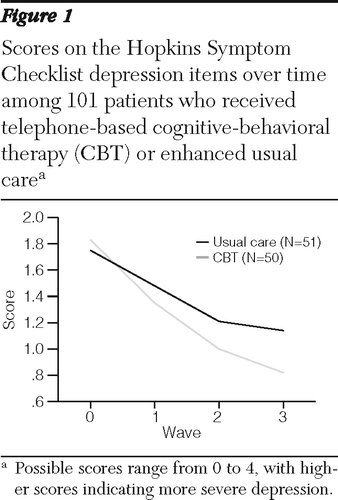
Figure 1 Scores on the Hopkins Symptom Checklist depression items over time among 101 patients who received telephone-based cognitive-behavioral therapy (CBT) or enhanced usual care
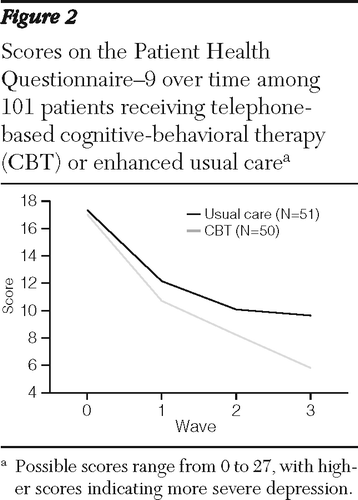
Figure 2 Scores on the Patient Health Questionnaire-9 over time among 101 patients receiving telephonebased cognitive-behavioral therapy (CBT) or enhanced usual care
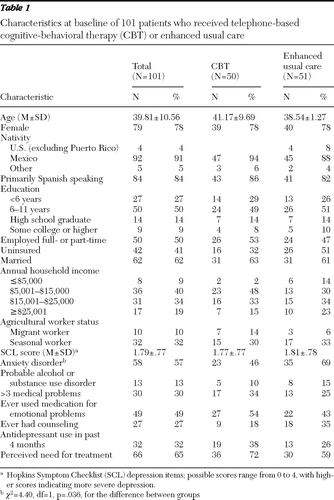
Table 1 Characteristics at baseline of 101 patients who received telephone-based cognitive-behavioral therapy (CBT) or enhanced usual care
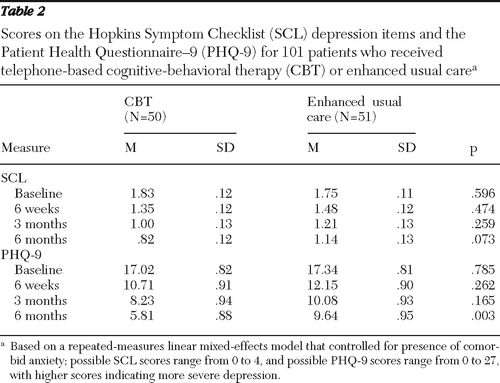
Table 2 Scores on the Hopkins Symptom Checklist (SCL) depression items and the Patient Health Questionnaire-9 (PHQ-9) for 101 patients who received telephone-based cognitive-behavioral therapy (CBT) or enhanced usual care
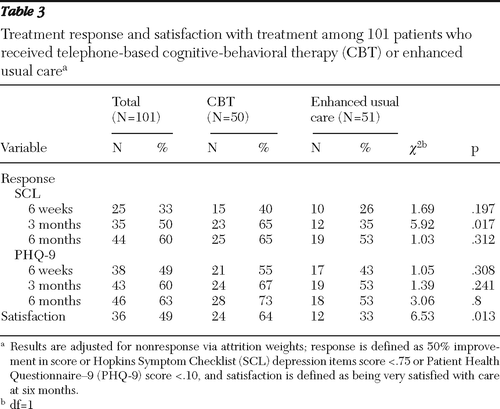
Table 3 Treatment response and satisfaction with treatment among 101 patients who received telephone-based cognitive-behavioral therapy (CBT) or enhanced usual care



